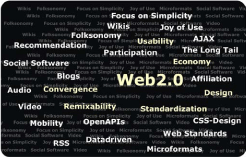|
|
|
JBoss Seam: Web 2.0 Applications
|
|
| |

JBoss Seam is a powerful new application
framework developed by JBoss, a division of
Red Hat for building next generation Web 2.0
applications. It unifies and integrates
technologies such as Asynchronous JavaScript
and XML (AJAX), Java Server Faces (JSF),
Enterprise Java Beans (EJB3), Java Portlets and
Business Process Management (BPM) into a
single unit i.e. SeamSeam is designed from the
ground, up to eliminate the complexities at the
architecture and the API level. It enables
developers to assemble complex web
applications with simple annotated Plain Old Java
Objects (POJOs), componentized UI widgets
and very little XML. The simplicity of Seam 1.0
will enable easy integration with the JBoss
Enterprise Service Bus (ESB) and Java Business
Integration (JBI) in the future.
Previously, creating J2EE 1.4 applications,
especially those involving web-based user
interface and back-end EJBs, required a lot of
tedious coding. Now JEE 5 and EJB 3, with their
focus on lightweight Java support, have planned
to reduce the code bloat for the developers.
However the specifications for JEE 5 along with
EJB3 are still not yet finalized, there is already
a framework available i.e. JBoss Seam, this
framework is built on top of JEE 5 and EJB3. It
aims to further reduce the code required for
building a functional application. Seam being, a
component framework promises to deliver fullfeatured
JEE 5 applications in a lightweight code
base i.e. requiring only a fraction of the code of
regular JEE applications.
JBoss Seam is a flexible web application
framework introduced for Java EE 5. It
eliminates the traditional tedious coding using
clever architecture. Seam provides a consistent |
|
and easy to understand streamlined
programming model for developing web based
applications. Seam enables to access any backend
EJB 3.0 component from the front-end
simply by addressing it with the Seam
component name.
JBoss Seam is compatible with most of the
available application servers which support EJB
3.0 public draft and JSF 1.1 implementation.
Seam is also usable with JBoss Micro- container
and Hibernate due to its unique approach to
maintain state management while not plugging
into Java EE 5 and EJB 3.
Seam framework provides a command line tool
seam-gen that can automatically generate a
CRUD (create-read-update-delete) web
application from the existing database. Seam
provides the concept of declarative application
state management for POJO component that
means Seam extends annotations defined in
EJB 3.0 having a new set of annotations for
declarative state management, declarative
context demarcation, state validation and
eliminating XML required by plain JSF.
Every Seam component exists within a context
as seam components are stateful and contextual
having a well defined container-managed
lifecycle. This approach helps to fix the bugs
and performance problems results in plague web
applications having non-linear or multi-window
navigation. Seam integrates with the JBoss
jBPM deeply to make the business process
management, a first class construct. Seam also
simplifies testing Java EE 5 applications in unit
test framework by enforcing the JBoss
Embedded EJB3 container. In other words, we
can say that Seam is completely for enhancing
developer’s productivity and application
scalability. |
|
Oct 2007 | Java Jazz Up |26 |
| |
|
| |
Pages:
1,
2,
3,
4,
5,
6,
7,
8,
9,
10,
11,
12,
13,
14,
15,
16,
17,
18,
19,
20,
21,
22,
23,
24,
25,
26,
27,
28,
29,
30,
31,
32,
33,
34,
35,
36,
37,
38,
39,
40,
41,
42,
43,
44,
45,
46,
47,
48,
49,
50,
51,
52,
53 ,
54,
55,
56,
57,
58,
59,
60,
61,
62,
63 ,
64,
65 ,
66 ,
67 ,
68 ,
69 ,
70,
71,
72,
73,
74,
75,
76,
77,
78,
Download PDF |
|
|
|
|
|
|
| |
| |
|